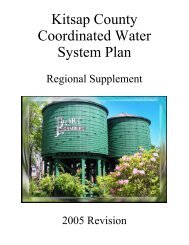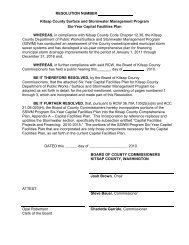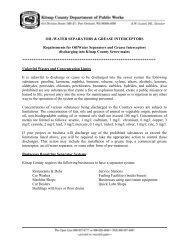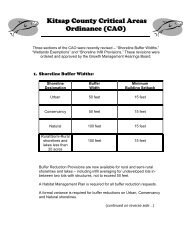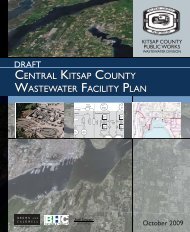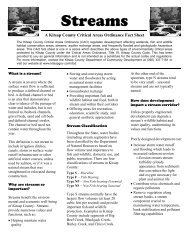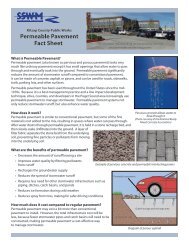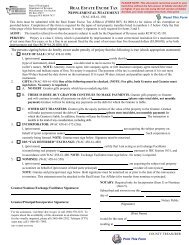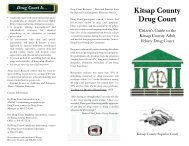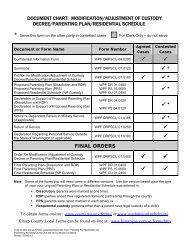surface & stormwater management performance audit final report
surface & stormwater management performance audit final report
surface & stormwater management performance audit final report
You also want an ePaper? Increase the reach of your titles
YUMPU automatically turns print PDFs into web optimized ePapers that Google loves.
Surface & Storm Water Management Performance Audit<br />
Kitsap County, Washington<br />
Final Report<br />
To implement these program elements, the SSWM Program has established a number of other<br />
programs and supporting activities (See Exhibit 2 in Chapter I) that are either consistent with the<br />
legislation’s purposes or good <strong>management</strong> practices.<br />
The watershed planning element is one area where a question has been raised about using<br />
SSWM revenues to support the Water Resource Inventory Area (WRIA) 15 watershed plan.<br />
Because it is considered a regional project that also includes cities and non-<strong>stormwater</strong> issues, a<br />
stakeholder group believes that it is inappropriate to use SSWM funding to support County staff<br />
time on the project. We did not specifically <strong>audit</strong> the WRIA 15 planning process or the<br />
timekeeping process, but the following provides a context to determine if such spending is<br />
inappropriate.<br />
• The purposes of the SSWM Program are very broad, and to the extent that WRIA 15<br />
planning efforts relate to any of the SSWM purposes, staff time could be considered<br />
appropriate if the issues relate to watersheds affecting the County’s unincorporated<br />
residents. Key purposes are protecting life and property from storm, waste, flood or<br />
surplus <strong>surface</strong> waters; protecting water quality from siltation, contamination, and<br />
erosions; protecting aquifers; and complying with federal and state <strong>surface</strong> water<br />
<strong>management</strong> and water quality regulations and legislation. In the 1996 Value Analysis<br />
Study performed for the SSWM Program, one of the value analysis concepts was to<br />
coordinate planning and develop partnerships with the groundwater <strong>management</strong> plan,<br />
state basin assessment program, watershed action plans, and others. According to the<br />
study, such coordination would eliminate duplication and or enhance the results of all<br />
plans and programs. Key questions are whether the Board of County Commissioners still<br />
considers such planning consistent with the purpose of protecting aquifers and whether<br />
the SSWM Program would send a representative to monitor the meetings and participate<br />
even if the County was not the lead agency in this effort.<br />
• The use of SSWM funding and Community Development’s role as it relates to the WRIA<br />
15 planning has been documented in the Department’s scope of work since 2002. Two of<br />
the objectives in the scope for watershed planning are to participate in the WRIA 15<br />
planning process and to coordinate the different watershed planning efforts.<br />
• Not all the time of SSWM funded staff and WRIA 15 costs are paid for by SSWM fees.<br />
As lead agency for the project, the County received a grant to pay some of its costs for<br />
coordinating the planning and conducting various studies. In 2004 the costs charged to<br />
the grant totaled $161,514. Staff costs charged for salaries and benefits were $13,500,<br />
while about $147,800 was charged for consulting and professional services. In 2005 the<br />
costs charged as of the end of August were $71,107 with only about $1,800 charged to<br />
salaries and benefits. Concerning SSWM expenditures for watershed planning in 2004,<br />
salaries and benefits costs were less than budgeted at 74% and for 2005, the salaries and<br />
benefits costs are running at 86% for the year. We did not determine what the<br />
appropriate time allocation should have been.<br />
• If the discussions and watershed planning efforts affect unincorporated County residents,<br />
the fact that cities are involved in a project does not necessarily mean that SSWM funds<br />
Page 9



